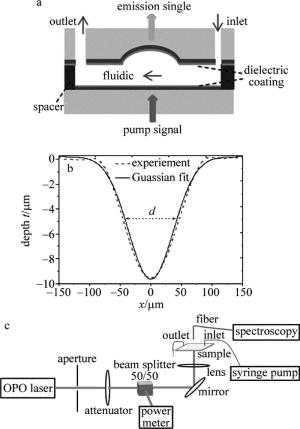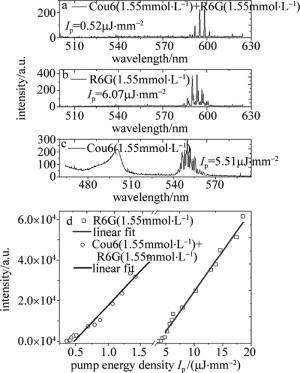-
光微流控是将光学检测元件集成于微流控芯片,协同提高微流控分析系统的功能集成度和便携性[1-2]。其中光微流激光作为一种发展前景良好的技术,吸引了越来越多的关注,主要因为其宽带可调的光谱范围、易于和微流控系统集成,以及在生物化学检测方面的潜在应用[3]。目前为止,人们制备了多种光学微谐振腔,如法布里-珀罗(Fabry-Perot,F-P)腔[4-7]、环形腔[8-11]、分布式反馈光栅[12-14]、光子晶体微腔[15]等。在这些微腔中,环形腔具有极高的腔品质因子(Q值)。但在环形腔中,腔与物质的相互作用是通过倏逝波场作用,增益介质中只有很少一部分参与受激放大;同时,增益介质溶液的折射率往往要高于环形腔本身材料的折射率。而F-P腔表现出以下优点:与微流控系统极好的兼容性、操作简单、可实现与增益介质的体相互作用,如细胞内激光的产生等;此外,采用F-P腔可选择任意折射率溶液作为增益介质载体。然而,目前的F-P微腔主要存在两点不足:(1)谐振腔Q值或精细度较低;(2)F-P微腔主要采用平面镜对平面镜的形式,在与微流控集成时极易造成倾斜损耗,增大了腔的抽运能量密度阈值。近来,作者采用CO2激光微加工和镀介质膜的方法,制备出了高Q值(4×105)、高稳定的平凹型(平面镜对凹面镜)光学F-P微腔,并实现了90nJ/mm2的低光微流激光抽运能量密度阈值[16]。这是目前实现得较好的F-P光学微腔之一,在激光抽运能量密度阈值方面略高于光学环形腔(25nJ/mm2)[9]。
以上光微流激光产生过程中,采用的是抽运源直接抽运增益介质的方式,这种抽运方式限制了增益介质和抽运源的选择灵活性,这种不足可通过荧光共振能量转移(fluorescence resonant energy transfer, FRET)的方式,即间接抽运的方式弥补,通过在微腔中引入额外的施主染料,由抽运施主染料实现能量从施主到受主染料的转移[17-18]。
因此,作者基于制备的高Q值、高稳定平凹型F-P光学微腔,研究了在间接抽运方式下,两种F-P光学微腔内FRET激光的产生。实验结果表明:在此种抽运方式下可实现0.48μJ/mm2的低激光抽运能量密度阈值;在激光检测方面,也可通过FRET的能量传递形式实现对低浓度物质的检测。
-
对荧光共振能量转移最早研究的是施主和受主染料的荧光能量转移方式,其中,非辐射Förster转移是最主要的一种机制[17-18]。单个施主分子和受主分子之间的能量转移效率Ef取决于施主与受主分子的浓度,以及施主和受主分子之间的距离,即:
${E_{\rm{f}}} = R_0^6/\left( {R_0^6 + {r^6}} \right) $
(1) 式中, r为施主和受主分子间的距离;R0是Förster距离,由施主和受主染料及其吸收/辐射谱决定。实验中作者采用的施主和受主染料分别是香豆素6(coumain 6,Cou6)和罗丹明6G(R6G)。为了确定两种染料分子的较高能量传递系数,首先测定了430nm脉冲激光抽运下,比色皿容器中不同浓度比混合液的荧光能量传递过程,图 1所示为不同浓度配比下两种染料混合液的荧光光谱。R6G的浓度CR6G和Cou6的浓度CCou6配比分别为0.2mmol·L-1/0.1mmol·L-1,1mmol·L-1/0.1mmol·L-1,1.5mmol·L-1/0.1mmol·L-1,2mmol·L-1/0.1mmol·L-1,3mmol·L-1/0.1mmol·L-1,3mmol·L-1/0mmol·L-1和0mmol·L-1/3mmol·L-1时对应图 1中的不同曲线。430nm对应Cou6较强的吸收峰,而对应R6G最弱的吸收峰。测试实验中,保持Cou6的浓度(CCou6=0.1mmol/L)不变,逐渐改变R6G的浓度。由于430nm抽运时,不同浓度的R6G荧光出射强度不同,因此只对比观测图 1中Cou6的荧光光谱变化。实验结果表明,当Cou6和R6G的浓度分别为0.1mmol/L和3mmol/L时,可实现较高的荧光能量转移,此浓度下计算出的距离r1=5.04nm。在此浓度下,为达到最高的转移效率,施主和受主的浓度应相等,即1.55mmol/L。在以下激光产生过程中,选用两种染料的浓度分别为1.55mmol/L。

Figure 1. Relationship between fluorescence intensity of FRET signal and wavelength at various concentrations of R6G (donor) and Cou6 (acceptor) under the same pump energy
FRET微流激光实验所用光微流芯片如图 2a所示,它是由微流通道和F-P微腔构成。其中F-P微腔是由一个平面镜和一个凹面镜形成,腔长为L,为满足F-P稳定腔条件,腔长L需小于凹面腔的最小曲率半径R。凹面结构采用CO2激光器微加工熔融石英玻璃表面形成;其表面形状可用高斯函数近似拟合(见图 2b),结构参量如深度t、宽度d及最小曲率半径R均可由CO2激光加工条件控制。实验中制备了两类结构参量不同的凹面形状,分别为Ⅰ类(t=1μm~4μm,d=30μm~40μm,R=90μm~200μm)和Ⅱ类(t=8μm ~13μm,d=85μm~105μm,R=250μm~400μm)结构。详细的CO2激光加工条件和微流芯片组装过程,请参考作者近期的工作[16]。平面镜和凹面镜分别由高反射率介质膜构成,其中Ⅰ类结构的介质膜高反中心在570nm,Ⅱ类结构的介质膜反射中心在600nm。

Figure 2. a—optofluidic chip with microfluidic channel and F-P microcavity b—profile of concave microwell with experimental data and Gaussian fit data c—experimental setup of FRET laser generation
实验中采用430nm脉冲光学参量振荡器(optical parametric oscillator, OPO)激光器,脉宽5ns,重复频率20Hz作为抽运源,实验装置示意图如图 2c所示,抽运能量可通过能量计实时测量。激光光束通过透镜聚焦后垂直入射到F-P微腔中,焦点处光斑直径约为100μm。增益介质Cou6(CCou6=1.55mmol/L)和R6G(CR6G=1.55mmol/L)溶于无水乙醇(折射率n=1.36)中,通过蠕动泵注入微流通道中,通道中溶液的流动速率约为3mm/s。
-
首先采用Ⅰ类凹面结构构成的F-P微腔作为微流激光腔,测量了增益介质为Cou6+R6G混合溶液下激光的出射情况。图 3a所示为抽运能量密度Ip=1.62μJ/mm2时出射激光的光谱,此光谱的中心波长约为590nm,自由频谱范围(free spectral range, FSR)为1.9nm,由此计算的激光腔长约为70μm。图 3b中给出了抽运能量密度为12.54μJ/mm2时的激光光谱,中心波长约为592nm。图 3d中的圆圈是在此混合溶液下激光的出射光强随抽运能量密度的变化关系,其中激光出射强度是通过积分求和激光光谱得到,积分范围从520nm~620nm; 图中线性拟合得到激光的激光抽运能量密度阈值约为1.52μJ/mm2;同时又测量了只有增益介质R6G(CR6G=1.55mmol/L)溶液时激光出射情况。图 3d中的方形点为对应的激光出射强度随抽运能量密度变化关系,线性拟合得到的激光抽运能量密度阈值约为9.2μJ/mm2。此抽运能量密度阈值要远高于混合溶液情况下激光的抽运能量密度阈值。这主要是因为当增益介质为Cou6+R6G的混合溶液时,激光的产生主要是通过间接的抽运方式实现,即430nm的抽运能量密度首先被Cou6吸收,然后通过Förster能量转移机制,实现能量从Cou6激发态到R6G激发态的转移,当激光腔中R6G的增益大于腔的损耗时,实现激光的发射。430nm对应Cou6较强的吸收峰,而R6G在此波长的吸收要弱很多。图 3c所示为只有Cou6(CCou6=1.55mmol/L)溶液、抽运能量密度Ip=2μJ/mm2时的光谱,此光谱对应Cou6的发射光谱。通过对比光谱图 3a~图 3c可知,混合溶液Cou6+R6G发射激光时主要采用间接的能量抽运方式。
为了实现更低的激光抽运能量密度阈值,接着测试了Ⅱ类凹面结构构成的F-P微流谐振腔的激光出射情况。抽运条件及增益介质的种类、浓度与Ⅰ类结构中相同。首次采用Cou6+R6G混合溶液作为增益介质,图 4a对应抽运能量密度Ip=0.52μJ/mm2时的激光出射光谱,其中心波长约为598nm,自由频谱范围为3.3nm,由此计算得到的激光腔长约为39μm。图 4b为只有增益介质R6G溶液、抽运能量密度Ip=6.07μJ/mm2时的出射光谱。图 4d中的圆圈点对应混合液下激光出射强度随抽运能量密度的变化关系,线性拟合表明激光抽运能量密度阈值约为0.48μJ/mm2。这是作者目前在F-P微谐振腔中通过FRET间接能量抽运实现的最低光微流激光出射阈值,是Ⅰ类结构中得到的抽运能量密度阈值的1/3,这主要得益于Ⅱ类结构镜面在600nm附近高的反射率系数及高的腔精细度。图 4d中的方形点为相应的激光出射强度随抽运能量密度的变化关系,线性拟合表明激光抽运能量密度阈值约为5.22μJ/mm2,相比于Ⅰ类结构,相同情况下的抽运能量密度阈值也下降了。图 4c为只有增益介质Cou6、抽运能量密度Ip=5.51μJ/mm2时的发射光谱。同样类比于Ⅰ类结构,通过对比图 4a~图 4c可知,430nm光源抽运混合溶液时间接的FRET激光抽运形式。
FRET作为一种能量传递方式,即通过施主和受主之间能量的传递,可实现受主增益介质间接的能量抽运,从而产生激光。而从传感检测方面,通过FRET激光作用也可实现对弱信号的检测。实验上使用Ⅰ类结构F-P微腔作为激光腔,首先采用R6G(CR6G=0.1mmol/L)溶液作为增益介质,在430nm激光抽运下,当抽运能量密度为76μJ/mm2时,仍没有探测到R6G的激光信号,如图 5a所示。随后在此溶液中加入Cou6增益介质(CCou6=3mmol/L),图 5b所示为抽运能量密度Ip=1.73μJ/mm2时,R6G的激光出射光谱(对应550nm~590nm的光谱),中心波长为569nm;其中460nm~530nm的信号对应Cou6的荧光光谱。图 5d为对应的激光出射能量随激光抽运能量密度的变化关系,其中激光能量是通过积分550nm~590nm的光谱强度得到,线性拟合表明, 激光抽运能量密度的阈值约为1.55μJ/mm2。为了排除此激光信号是由Cou6产生,图 5d中给出了只有Cou6(CCou6=3mmol/L)的出射光谱,其激光中心波长为540nm。由此,通过对比图 5a~图 5c可以得出,混合溶液Cou6+R6G下激光出射是FRET的能量传递的结果,同时也表明,采用FRET激光出射的方式可实现对低浓度物质(CR6G=0.1mmol/L)的间接检测。
-
基于制备的高Q值、高稳定F-P光微流谐振腔,研究了两种不同类型微腔结构下,通过荧光共振能量转移(FRET)的方式实现激光的出射,即FRET激光的产生。实验结果表明,在此种抽运方式下,在F-P光微流激光腔中可实现0.48μJ/mm2的低激光抽运能量密度阈值。进一步实验结果表明,也可通过FRET激光产生的能量形式实现对低浓度物质的检测。
基于法布里-珀罗微腔的光微流FRET激光产生
Generation of optofluidic FRET laser based on Fabry-Perot microcavity
-
摘要: 为了实现低阈值光微流荧光共振能量转移(FRET)激光,基于制备的高品质因子、高稳定法布里-珀罗(F-P)微腔,采用间接抽运方法研究了两种F-P谐振腔中光微流FRET激光的产生。直接抽运施主染料,使得施主染料通过FRET的方式把能量传递给受主染料,从而实现受主染料的间接能量抽运。结果表明,在此种抽运方式下,F-P光微流激光腔中实现了0.48μJ/mm2的低激光抽运能量密度阈值;并可通过FRET激光产生的形式实现对低浓度物质的检测。Abstract: In order to achieve low-threshold optofluidic fluorescence resonant energy transfer(FRET) laser, based on Fabry-Perot (F-P) microcavity with high quality factor and stability, the generation of optofluidic FRET laser in two types of F-P resonator was studied by using indirect pumping method. Firstly, donor molecules were pumped directly, and then, the excited energies of donor molecules were transferred to acceptor molecules through FRET to realize the indirect optical pumping of the acceptor. Experimental results show that the low energy density threshold of laser pump is 0.48μJ/mm2 in F-P optofluidic cavity. The results indicate that the detection of low concentration substance can be realized by FRET laser generation in terms of laser detection.
-
Figure 3. Laser intensity under different conditions for F-P cavities on type Ⅰ chip
a—signal emission intensity and wavelength of Cou6+R6G and Ip=1.62μJ/mm2 b—signal emission intensity and wavelength of R6G and Ip=12.54μJ/mm2 c—signal emission intensity and wavelength of Cou6 and Ip=2μJ/mm2 d—laser intensity vs. pump density of Cou6+R6G and R6G
Figure 4. Laser intensity under different conditions for F-P cavities on type Ⅱ chip
a—signal emission intensity and wavelength of Cou6+R6G and Ip=0.52μJ/mm2 b—signal emission intensity and wavelength of R6G and Ip=6.07μJ/mm2 c—signal emission intensity and wavelength of Cou6 and Ip=5.51μJ/mm2 d—laser intensity vs. pump density of Cou6+R6G and R6G
Figure 5. Emission intensity under different conditions for F-P cavities on type Ⅰ chip
a—signal emission intensity and wavelength of R6G and Ip=76μJ/mm2 b—signal emission intensity and wavelength of R6G+R6G and Ip=1.73μJ/mm2 c—signal emission intensity and wavelength of Cou6 and Ip=1.4μJ/mm2 d—laser intensity vs. pump density of Cou6+R6G
-
[1] PSALTIS D, QUAKE S R, YANG C. Developing optofluidic technology through the fusion of microfluidics and optics[J]. Nature, 2006, 442(7101):381-386. doi: 10.1038/nature05060 [2] FAN X D, WHITE I M. Optofluidic microsystems for chemical and biological analysis[J]. Nature Photonics, 2011, 5(10):591-597. doi: 10.1038/nphoton.2011.206 [3] FAN X, YUN S H. The potential of optofluidic biolasers[J]. Nature Methods, 2014, 11(2):141-147. doi: 10.1038/nmeth.2805 [4] GALAS J C, TORRES J, BELOTTI M, et al. Microfluidic tunable dye laser with integrated mixer and ring resonator[J]. Applied Physics Letters, 2005, 86(26):264101. doi: 10.1063/1.1968421 [5] KOU Q, YESILYURT I, CHEN Y. Collinear dual-color laser emission from a microfluidic dye laser[J]. Applied Physics Letters, 2006, 88(9):091101. doi: 10.1063/1.2179609 [6] AUBRY G, KOU Q, SOTO-VELASCO J, et al. A multicolor microfluidic droplet dye laser with single mode emission[J]. Applied Physics Letters, 2011, 98(11):111111. doi: 10.1063/1.3565242 [7] KUEHNE A J, GATHER M C, EYDELNANT I A, et al. A switchable digital microfluidic droplet dye-laser[J]. Lab on A Chip, 2011, 11(21):3716-3719. doi: 10.1039/c1lc20405j [8] AZZOUZ H, ALKHAFADIJI L, BALSLEV S, et al. Levitated droplet dye laser[J]. Optics Express, 2006, 14(10):4374-4379. doi: 10.1364/OE.14.004374 [9] LACEY S, WHITE I M, SUN Y, et al. Versatile opto-fluidic ring resonator lasers with ultra-low threshold[J]. Optics Express, 2007, 15(23):15523-15530. doi: 10.1364/OE.15.015523 [10] WU X, SUN Y Z, SUTER J D, et al. Single mode coupled optofluidic ring resonator dye lasers[J]. Applied Physics Letters, 2009, 94(24):241109. doi: 10.1063/1.3156861 [11] CHANDRAHALIM H, CHEN Q, SAID A A, et al. Monolithic optofluidic ring resonator lasers created by femtosecond laser nanofabrication[J]. Lab on A Chip, 2015, 15(10):2335-2340. doi: 10.1039/C5LC00254K [12] LI Z Y, ZHANG Z Y, EMERY T, et al. Single mode optofluidic distributed feedback dye laser[J]. Optics Express, 2006, 14(2):696-701. doi: 10.1364/OPEX.14.000696 [13] GERSBORG-HANSEN M, KRISTENSEN A. Optofluidic third order distributed feedback dye laser[J]. Applied Physics Letters, 2006, 89(10):103518. doi: 10.1063/1.2345602 [14] SONG W H, VASDEKIS A E, LI Z Y, et al. Low-order distributed feedback optofluidic dye laser with reduced threshold[J]. Applied Physics Letters, 2009, 94(5):051117. doi: 10.1063/1.3079799 [15] ZHEN B, CHUA S L, LEE J, et al. Enabling enhanced emission and low-threshold lasing of organic molecules using special Fano resonances of macroscopic photonic crystals[J]. Proceedings of the National Academy of Sciences of the United States of America, 2013, 110(34):13711-13716. doi: 10.1073/pnas.1311866110 [16] WANG W, ZHOU C, ZHANG T, et al. Optofluidic laser array based on stable high-Q Fabry-Perot microcavities[J]. Lab on A Chip, 2015, 15(19):3862-3869. doi: 10.1039/C5LC00847F [17] FORSTER T H. Transfer mechanisms of electronic excitation energy[J]. Radiation Research Supplement, 1960, 9(1):326-339. [18] WU P G, BRAND L. Resonace energy transfer:methods and applications[J]. Analytical Biochemistry, 1994, 218(1):1-13. -


 网站地图
网站地图

 下载:
下载:





